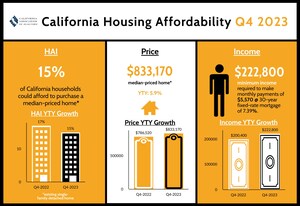LOS ANGELES, April 24, 2017 /PRNewswire-USNewswire/ -- Even with a strong performance in March closed escrow sales, a shortage of available homes and robust price growth that's eating away at affordability stifled pending home sales for the third straight month, the CALIFORNIA ASSOCIATION OF REALTORS® (C.A.R.) said today.
Following seasonal factors, REALTORS® responding to C.A.R.'s March Market Pulse Survey** saw elevated market activity, with an increase in floor calls, presentations, and open house traffic for the third month in a row.
Pending home sales data:
- Based on signed contracts, statewide pending home sales decreased for the third straight month in March on a seasonally adjusted basis, with the Pending Home Sales Index (PHSI)* declining 4.5 percent from 112.5 in March 2016 to 107.4 in March 2017. On a monthly basis, California pending home sales dipped 2.9 percent from the February index of 110.6.
- March's pending sales decline is the greatest so far this year, portending sales activity in the usually busy spring homebuying season will be dampened, primarily due to demand outstripping the supply of active listings, which was 12 percent lower than in March a year ago.
- At the regional level, Southern California remains the bright spot in the state, which led both in closed escrow sales in March and the smallest decrease (-1.3 percent) in March non-seasonally adjusted pending sales. In fact, Los Angeles and Riverside counties were the only two areas of Southern California that saw an increase in pending sales from a year ago, at 1.6 percent and 3.1 percent, respectively. Pending sales fell 3.6 percent from March 2016 in Orange County, 5.6 percent in San Diego County, and 8.0 percent in San Bernardino County.
- For the San Francisco Bay Area as a whole – which continues to be plagued by a shortage of homes on the market and eroding affordability – non-seasonally adjusted pending sales were down year-to-year for the sixth straight month, with every tracked county in the region experiencing a significant drop in pending sales activity. The Bay Area pending sales index fell 10.1 percent from 179.2 in March 2016 to 161.0 in March 2017. Monterey and Santa Cruz counties experienced the largest year-to-year reductions in pending sales of 17.3 percent and 16.4 percent, respectively. Pending home sales fell 15.9 percent from the previous year in San Francisco County, 14.9 percent in Santa Clara County, and 8.6 percent in San Mateo County.
- Pending sales in the Central Valley Region fell 5.5 percent from 96.3 in March 2016 to 91.0 in March 2017. Within Central Valley, pending sales edged up 0.4 percent in Kern County, while they were down 3.7 percent in Sacramento compared with a year ago.
- In C.A.R.'s newest market indicator of future price appreciation, Market Velocity – home sales relative to the number of new listings coming on line each month to replenish that sold inventory – suggests the increase in prices continues to be a supply-driven phenomenon and that price growth should continue through the summer.
Year-to-Year Change in Pending Sales by County/Region
| County/Region/State |
March 2017 |
March 2016 |
Yearly % Change |
| Counties |
|||
| Kern |
84.6 |
84.2 |
0.4% |
| Los Angeles |
93.4 |
92.0 |
1.6% |
| Orange |
83.3 |
86.4 |
-3.6% |
| Riverside |
62.0 |
60.1 |
3.1% |
| San Diego |
139.2 |
147.5 |
-5.6% |
| San Bernardino |
76.2 |
82.8 |
-8.0% |
| Monterey |
60.0 |
72.6 |
-17.3% |
| Sacramento |
70.1 |
72.8 |
-3.7% |
| San Francisco |
76.9 |
91.5 |
-15.9% |
| San Mateo |
90.5 |
99.0 |
-8.6% |
| Santa Clara |
88.5 |
104.0 |
-14.9% |
| Santa Cruz |
89.2 |
106.7 |
-16.4% |
| Regions |
|||
| San Francisco Bay Area |
161.0 |
179.2 |
-10.1% |
| Southern California |
113.9 |
115.4 |
-1.3% |
| Central Valley |
91.0 |
96.3 |
-5.5% |
| California (SA)* |
107.4 |
112.5 |
-4.5% |
* Seasonally adjusted
March REALTOR® Market Pulse Survey**:
Entering the spring homebuying season, California REALTORS® responding to C.A.R.'s March Market Pulse Survey continue to be optimistic about market conditions in the near term, reporting an increase in floor calls, listing appointments, open house traffic, as well as an increase in multiple offers, compared to February.
- The share of homes selling above asking price rose from 34 percent a year ago to 39 percent in March. Conversely, the share of properties selling below asking price dipped to 32 percent from 33 percent in March 2016. The remaining 29 percent sold at asking price, down from 34 percent in March 2016.
- For homes that sold above asking price, the premium paid over asking price was essentially unchanged from a year ago at 9.2 percent.
- The 38 percent of homes that sold below asking price sold for an average of 8 percent below asking price in March, compared to nearly 10 percent a year ago.
- The share of properties receiving multiple offers trended higher for the third straight month to the highest level since February 2016. Nearly three-fourths of properties for sale (74 percent) received multiple offers in March, up from 50 percent in March 2016.
- The share of properties receiving three or more offers in March was 45 percent, compared to 49 percent a year ago.
- The market for homes priced under $200,000 was the most competitive in March, posting the largest gain in receiving three or more offers, rising from 31 percent in March 2016 to 47 percent in March 2017.
- As prices become more in line with the market, listing price reductions declined to 19 percent in March, down from 21 percent in March 2016.
- A lack of available inventory continued to be the top concern for 37 percent of REALTORS®, the highest level in a year. Eroding housing affordability/high interest rates concerned 34 percent of REALTORS®. Inflated home prices/housing bubble was cited by nearly 17 percent of REALTORS®. A slowdown in economic growth, lending and financing, and policy and regulations rounded out REALTORS®' remaining biggest concerns.
- REALTORS®' expectations of market conditions over the next year remained high at an index of 64, up from an index of 60 a year ago.
Graphics (click links to open):
- YTY change in pending home sales by region.
- Pending sales vs. closed escrow sales.
- Share of properties receiving multiple offers.
- Price range of homes receiving 3+ offers.
- Lack of inventory tops REALTORS®' concerns.
- Market Velocity – indicator of future price appreciation.
Follow us on Twitter @CAR Media and @CAREALTORS®
Like us on Facebook, and check us out on Instagram.
*Note: C.A.R.'s pending sales information is generated from a survey of more than 70 associations of REALTORS® and MLSs throughout the state. Pending home sales are forward-looking indicators of future home sales activity, offering solid information on future changes in the direction of the market. A sale is listed as pending after a seller has accepted a sales contract on a property. The majority of pending home sales usually become closed sales transactions one to two months later. The year 2008 was used as the benchmark for the Pending Homes Sales Index. An index of 100 is equal to the average level of contract activity during 2008.
**C.A.R.'s Market Pulse Survey is a monthly online survey sent to more than 10,000 California REALTORS® to measure data about their last closed transaction and sentiment about business activity in their market area for the previous month. Approximately 300 REALTORS® responded.
Leading the way...® in California real estate for more than 110 years, the CALIFORNIA ASSOCIATION OF REALTORS® (www.car.org) is one of the largest state trade organizations in the United States with more than 190,000 members dedicated to the advancement of professionalism in real estate. C.A.R. is headquartered in Los Angeles.
SOURCE CALIFORNIA ASSOCIATION OF REALTORS
Related Links
WANT YOUR COMPANY'S NEWS FEATURED ON PRNEWSWIRE.COM?
Newsrooms &
Influencers
Digital Media
Outlets
Journalists
Opted In






Share this article